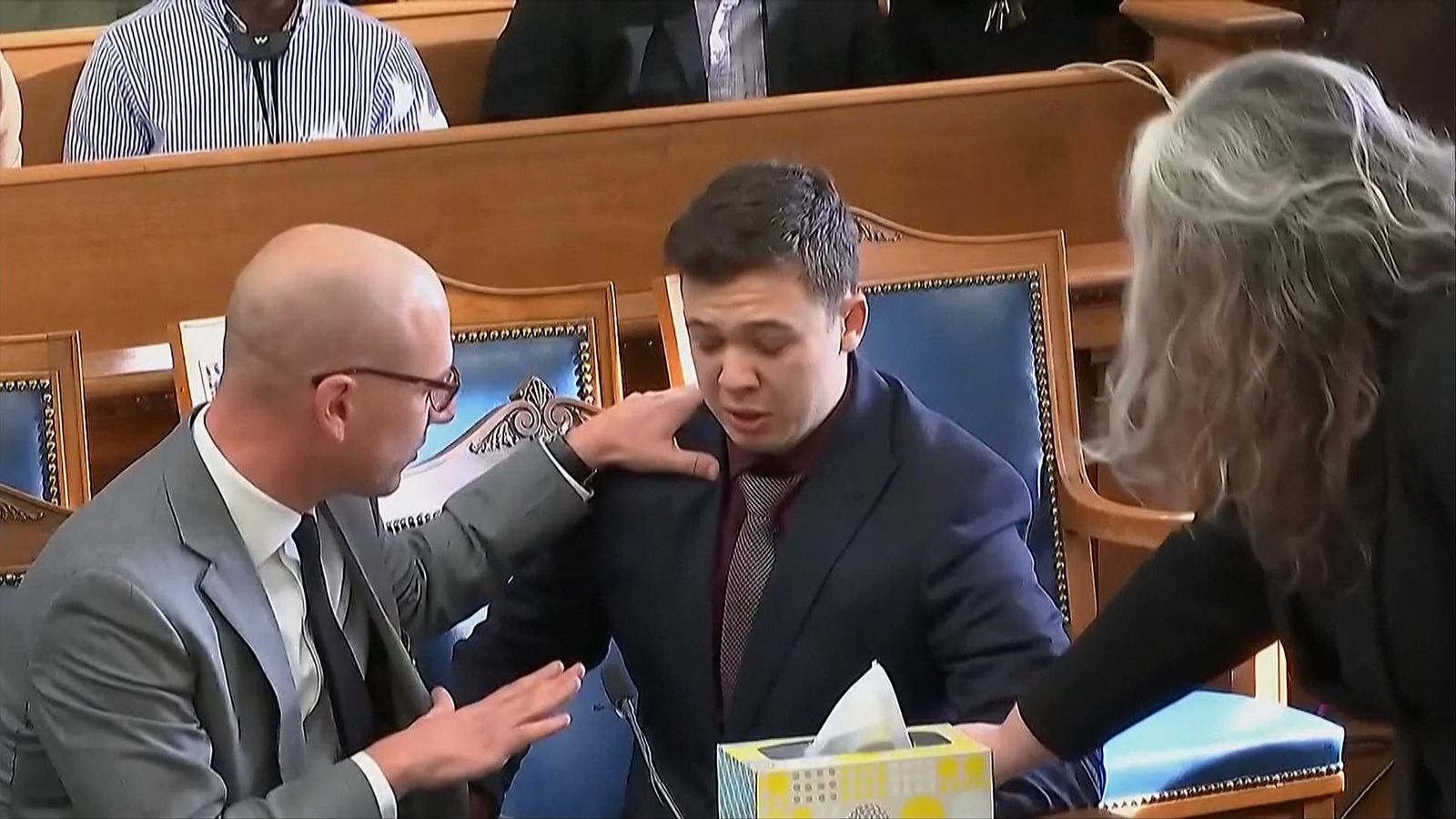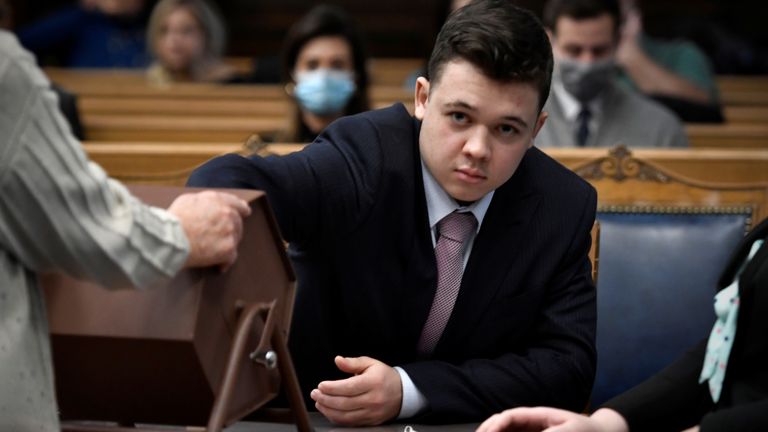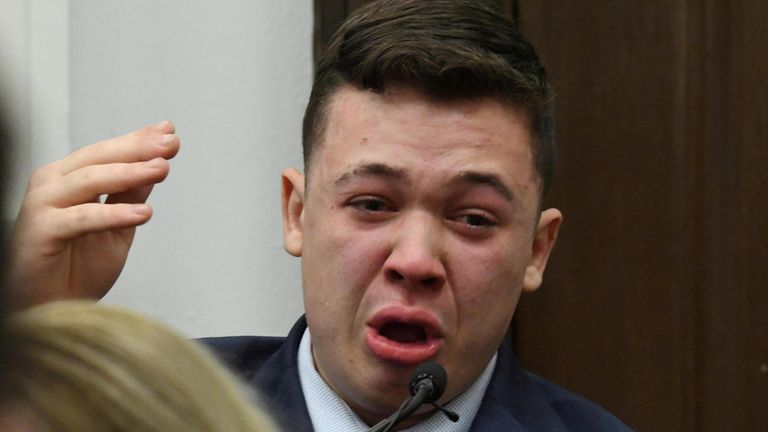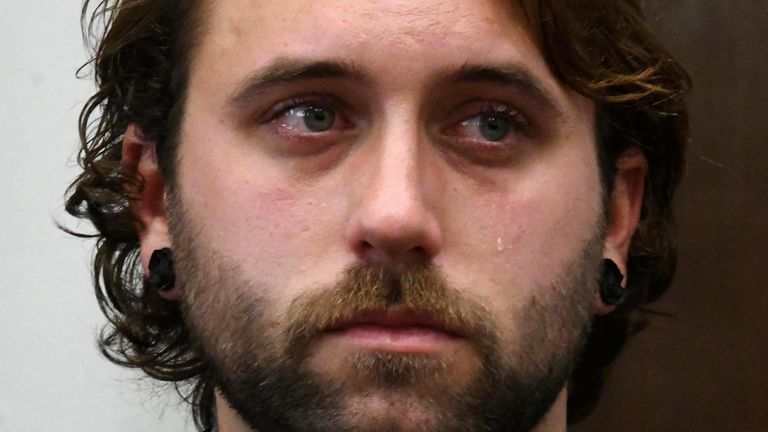A teenager has been found not guilty of the murders of two men and the attempted murder of a third at a demonstration in Wisconsin.
Kyle Rittenhouse, 18, was arrested and charged last year after the widely publicised incident in Kenosha during protests sparked by the shooting of a black man, Jacob Blake, by a white police officer in August 2020.
As the verdicts were read out, he broke down in tears, while jurors remained stoic and emotionless.
The families of those who were shot held hands and cried.
Rittenhouse, who was 17 at the time of the shootings, had travelled from the neighbouring state of Illinois.
He claimed in court that he had been asked to help protect the community by a local business owner.
The jury of 12 had been selected from a wider group of 18 who had listened to the evidence over two weeks.
In an unusual move, marking the end of a trial full of suspense and drama, Rittenhouse himself was asked to select the jurors by pulling six pieces of paper with their names on them from a lottery tumbler – a task usually carried out by a court clerk.
The six jurors he selected were designated as alternative jurors while the remaining 12 became the deliberating jurors.
The jury had been asked to consider two widely conflicting narratives which led to the shooting of the three men.
The prosecution had argued that Rittenhouse was a “wannabe soldier” and a vigilante who had travelled to Kenosha bent on stirring trouble at the protest.
Prosecutor Thomas Binger had argued that the teenager had caused a deadly chain of events by bringing a legally owned automatic AR15 rifle to a protest, walking about like “a hero in a western” and that he was “looking for trouble”.
During the protest, Rittenhouse first shot Joseph Rosenbaum, 36, who was unarmed.
He then shot Anthony Huber, 26, who had struck the defendant with a skateboard. He was also killed.
The third man to be shot, Gaige Grosskreutz, 28, was carrying a pistol.
He was injured and gave evidence for the prosecution.
The court saw footage from a drone which the prosecution argued showed the defendant pointing his weapon at people.
“This is provocation,” the prosecuting attorney had argued. “This is what starts this incident.”
Rittenhouse’s defence attorney, Mark Richards, argued that his client was acting in self-defence after coming under attack at the protest.
Mr Richards said Rittenhouse had travelled to the city to act as a medic and to protect property.
The defence had cast the first of Rittenhouse’s targets as a “crazy person”.
Mr Richards argued that Joseph Rosenbaum ambushed the defendant who had feared that his rifle would be taken from him and used against him.
At times during proceedings, Rittenhouse broke down in tears as he gave his own evidence.
In the hours before the verdict came in, Wisconsin’s governor issued a statement calling for calm whatever the court decided.
Governor Tony Evers said: “Kenoshans are strong, resilient, and have worked hard to heal and rebuild together over the past year. Any efforts to sow division and hinder that healing are unwelcome in Kenosha and Wisconsin. Regardless of the outcome in this case, I urge peace in Kenosha and across our state.”
Writing on Twitter, Mr Evers added: “Please respect the Kenosha community and their efforts to come together. I ask all those who choose to assemble and exercise their First Amendment rights in every community to do so safely and peacefully.”
About 500 members of the Wisconsin National Guard have been placed on standby in an undisclosed location 60 miles from the city to move in at the order of the governor.
The units will not be deployed unless the local police in the city requests their assistance. Their role will be limited to protecting locations deemed critical infrastructure and cultural institutions.
Residents of the city are nervous having experienced the significant unrest last summer in the wake of the shooting by police of 29-year-old Jacob Blake.
The shooting – one of a number last year by police against the black community – promoted widespread protests in Kenosha.
In his closing instructions to the jurors, the judge, Bruce Schroeder explained that in order to accept Rittenhouse’s claim of self-defence, they must accept that he believed there was an unlawful threat to him and that the force he used was “reasonable and necessary”.




